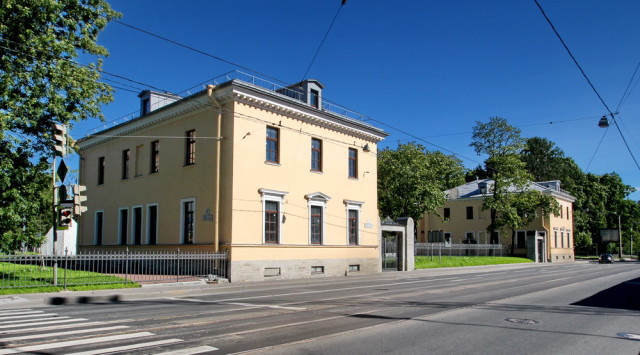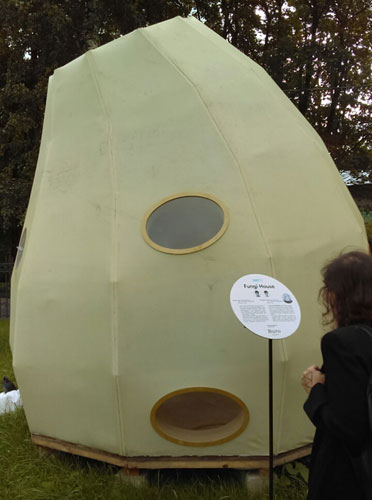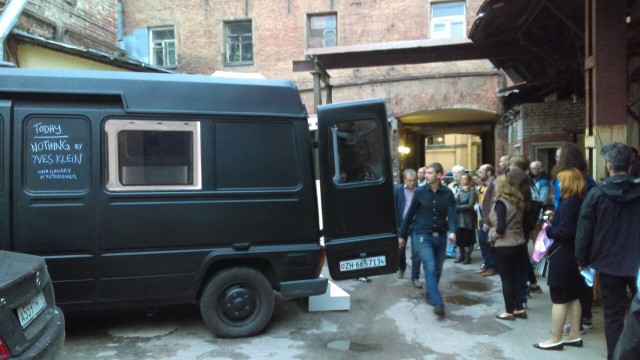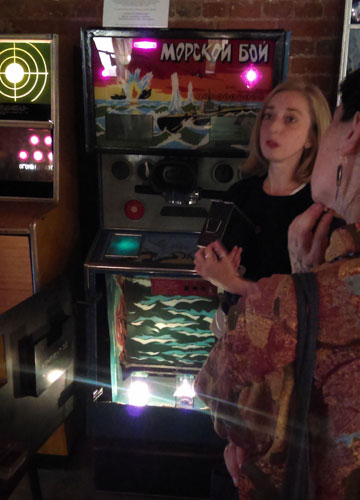
The Yarky hostel and artist residency program in St. Petersburg
Across the street from where I’m working is a hundred foot tall iron screw, which I’m told will drill the foundation for some lux apartments. Six residents of Flux Factory and I are at Yarky, a new artists’ hostel & exhibition space that’s struggling to finance completion of construction, while a bit nervous about what their new neighbors could mean. In other words, St. Petersburg, Russia does share some of the same woes as NYC.
We were invited here by CEC Artslink & The Trust for Mutual Understanding to participate in the Art Prospect Festival on Sept 17-21, an international public art fair in its fourth year. As I write, we’re paper-macheing forty piñatas we’ll smash in an arboretum across from Yarky. We’re here all September making art, exploring cultural spaces, and meeting artists. Since there aren’t many English accounts of St. Petersburg’s cultural scene beyond the large museums, I’ll share some perceptions of the artistic underground here, and check back soon with a second piece soon about how Art Prospect went.
Yarky, Art Prospect’s venue this year, is in the middle of their own summer long festival. Through an open competition, Yarky commissioned five architects to create conceptual sleeping pods in their huge courtyard; those included a camera obscura bedroom, a rocking “cradle” structure, and this li’l fungal nub:

Rial and Carro’s Fungi House at Yarkyfest
I like to say that a city needs lots of abandoned buildings & loose regulations to breed artist-led spaces, and I’m told St. Petersburg’s squats were mostly vacated a few years back. So I think Yarky, once fully operational, will be an important fixture for St. Petersburg. Contemporary art is concentrated almost entirely in the city center; Yarky pushes new cultural ideas into the northern outskirts of town, can house international artists cheaply, has great production & public gathering facilities, and as evidenced by the sleeping pods commission has already started off with a fun first commission series.
A few nights after we landed, our group attended the season opening at the nonprofit Luda Gallery, which started things off with a pop-up of the No Show Museum. Luda’s proprietor, Peter Belyi, seemed slightly apologetic that the audience of about 75 came to see an empty gallery. But No Show’s curator Tino Sehgal owned his concept: 24 invisible artworks were exhibited that night, on which Tino lectured. Tino is touring throughout Eastern Europe in a van and will eventually land at the Venice Biennale, with a little “exhibition space” in the bank of the van; at each pop-up, he lectures on examples & theory of immaterial conceptual works. In addition to the tour, No Show Museum does have an exhaustive website on the subject. Hosting international artists and giving a home to small communities of emerging artists is a central goal for Luda, which did get a nice English feature on Calvert Journal; that publication is worth perusing for its omnivorous coverage of Eastern European culture.

The lot outside Gallery Luda with the roving No Show gallery
The following day we met two artists, who will come to Flux for a residency this winter, TOK founders Anna Bitinka and Maria Veits. They are in the middle of a lengthy and ambitious project in a public park, the fourth iteration of Critical Mass. During this two-year project the artists will use a variety of performances and events to create collective energy around revitalizing an abandoned building in the park, Gromov’s Dacha. Convincing park officials to host an art project in itself can be bureaucratically dizzying in St. Petersburg, and so an entire year was spent framing the public events as a productive social tool both to officials and the neighborhood at large.
The weekend we visited, the public event phase was just beginning. An artist stood at the mouth of the park, asking passer-bys to share their memories of Gromov’s Dacha and give ideas for what they’d like it to become; the artist illustrated their thoughts on a 30 foot long banner on the park’s gate. Maria explained that while participants were stand-offish at first, over the course of the weekend people broke out of their shells and shared more ideas than could fit on the banner.
The following weekend, TOK held a picnic, and more performances are planned. In one performance residents strung ropes strung from their apartment windows across the street to trees and other objects in the park. I saw this as a gesture of a large group of neighbors sharing their private spaces for a community project.
I marvelled at the success of this project: Getting people to appreciate contemporary art is always tough; getting an entire neighborhood to work together on an art project for a long-term civic planning process is wildly ambitious. The fact that they have been able to achieve any of this at all is a testament to their dedication and skill.

Citizens provided ideas, illustrated on this banner, regarding an abandoned building in the park, TOK Founder Maria Veits explains.”
Social Engagement artists like TOK are not entirely new to St. Petersburg. Chto Delat is perhaps St. Petersburg’s most internationally visible arts collective, having performed political interventions through a loosely knit group since 2003. The Art Prospect festival itself this year has a strong theme of collectivism; these groups I’ll describe in greater depth in my next dispatch.
Despite the complaint of many folks that I’d spoken with that few independent spaces in town remain, many seemed unaware of “The Space”, a concert hall a bit like Brooklyn’s Baby’s All Right. There we saw experimental pioneer Nurse With Wound give a droney audiovisual performance, which lasted from about 11pm to 5:30am in front of a sleeping audience on comfy beanbag chairs. My friend commented that the back bar/restaurant area’s décor reminder her of Twin Peaks, which was a funny coincidence since Xiu Xiu are scheduled to cover the Twin Peaks theme music there in October. We had hamburgers and strong cocktails next to foosball tables and a booth where sleep-inducing tea was sold. Meanwhile some guy lectured for over an hour in Russian on Heidegger and what our bartender only described as “something weird”. After an intermission, Nurse With Wound projected blurry, convoluted overlays of microscopic organisms and psychedelic swirls while a sonic dreamscape of dark ragas, droning synthesizers and concrete sounds played quietly enough to hear the occasional snoring audience member.
After emerging from a semi-conscious trance of 6 hours with Nurse With Wound, we walked home through the abandoned warehouses while moon and stars turned to daylight. From reviewing their calendar, the Space’s programming on the whole seems hit and miss. But the Moscow-based DIY bookers Arcto Promo, who invited Nurse With Wound, seem to reliably bring in freaky, dark musicians like Death In June, Prurient, Jozef Van Wissem, &c.
The following day, we visited the Museum of Soviet Arcade Machines. Their original Moscow location was so successful that they recently opened a second St. Petersburg location in a lovely brick-ceilinged space. The organization permanently hosts over 60 coin operated arcade cabinets and a new expansion space for temporary exhibitions & public events. Nostalgia for retro gaming seems the main draw for their predominately 20/30-something crowd, and the design and subject matter of the games give a fascinating window into Russia’s culture & international position. Government mandated Soviet Realism meant no Space Invaders or Pac Men. In Repka (Radish), the player pulls a handle to try to match Grandpa’s radish-pulling strength. Morskoi Boi (Sea Battle), a series of mirrors in a painted chamber create a long field of depth through a mock periscope; blinking LEDs signify that a missile has been shot at a rotating string of paper ships – when “struck”, a synthesizer produces white noise, and lights black out except for one fiery red bulb. All these varied design strategies make the game feel immersive — the game was so popular years ago that devices to keep kids from using fake coins to play were invented.

Our guide reveals the chamber inside of Sea Battle
After the Soviet Union collapsed, Russian culture’s curiosity for exotic Western video games deflated the market for these products. The hulking Russian cabinets (designed to be heavy because a factory’s productivity was measured in kilos shipped) and their component parts are not produced any more, so the Museum’s staff reverse engineers fixes for the obsolete technology. (If you’d like to dig deeper about the space, Atlas Obscura and Motherboard have done an larger amount of research on this subject hosting photographs of the games, analysis of the history of the games, and interviews with staffers.)
As I’m finishing this first piece on St. Petersburg, we’ve just opened the Art Prospect festival and I’m taking off for the day to help folks smash some pinatas. Later tonight Flux will DJ a ping pong tournament at the Museum of Soviet Arcade Games! I’ve been amazed by how open and friendly the people here are, and I’m just starting to get a handle on what this city and the cultural landscape mean. As my thoughts on things coalesce, I’ll pen it all down for y’all.
Nat Roe is the Executive Director of the New York based residency program, Flux Factory, and is in St. Petersburg for the rest of the month.


Comments on this entry are closed.